
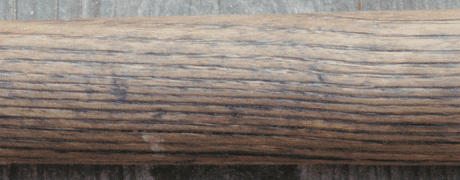
Although the previous method for making boiled linseed oil was fully simplified, it was not fully optimized. The large amount of catalyst dissolved poorly, the steel pan tended to discolor the oil, and the drying time could potentially be improved. After a period of experimentation, I was able to significantly improve my boiled linseed oil without adding any complexity to the production process.
To make a batch of this oil, I began by adding 100g of raw linseed oil and 400mg of ferric acetate (ground in oil to make a paste) to a large (7 inch diameter) crystallizing dish that I found on Ebay for $20. I then brought it to 220°C on my hot plate, at which point the catalyst completely dissolved, temporarily producing a strong vinegar smell and turning the oil a transparent dark red. I then maintained it at this temperature for four hours, which I found to be the longest reliable duration before the oil starts to solidify. At this point, a drop of oil rubbed on cold glass will have significant friction rather than feeling slippery; this appears to be a reliable indicator, and I will likely use it later when preparing larger batches of oil. I then let the oil cool to room temperature, and transferred it to a small mason jar. The steps of this process can be seen below.
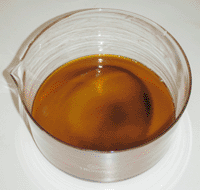
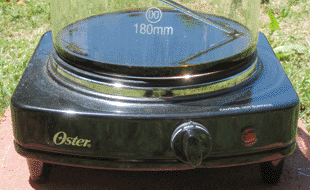
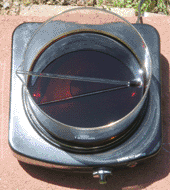
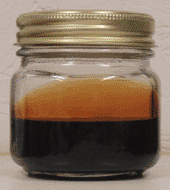
Oil produced this way is extremely fast-drying; a thin layer on glass will dry to a rubbery film in three hours in sunlight, and overnight indoors. It is also highly viscous; not to the extent that it is difficult to apply, but likely near that limit. Whether this is desirable is a matter of personal preference, but if a more fluid oil is needed it can be thinned with turpentine. As a practical test, I decided to apply it to the badly-weathered handle of an old shovel, which had been left outdoors long beyond the point where the original lacquer had flaked off. The oil wiped on easily by hand, soaked well into the wood, and could be buffed to a soft shine with a rag. It appeared to dry overnight, but I sat the shovel in the sun for a day to be sure. A before-and-after comparison can be seen at the top of the page. The color of the wood was greatly improved, and the texture became softer, providing a better grip. Hopefully the oil will help bind together the wood fibers and prevent further splitting, but only time will tell as to whether this treatment improved the longevity of the shovel. Overall, though, I am highly pleased with these results, and this type of boiled linseed oil will likely become my go-to finish for wooden objects that are subject to frequent handling.
Although cast iron and stainless steel react with this oil at high temperatures, surprisingly aluminum does not. This allows for the use of disposable trays which, unlike glassware, do not need to be cleaned and have no risk of cracking from thermal shock. In particular, I have found that heavy-duty pie pans work very well for making small batches of oil. This should make this process more accessible, since large pyrex dishes are admittedly somewhat hard to find.
EDIT: 8/23/2020At this point, the manufacture of this oil has become a routine part of my workshop, and I believe I have optimized the process to the greatest extent practical, at least for small-scale production. I have recorded an instructional video demonstrating this, in which I use readily-available equipment to prepare a small batch of oil.
EDIT: 9/30/2023Contrary to earlier expectations, I have discovered two further optimizations for this process. First, a muller and slab should be used to grind the ferric acetate into the oil, rather than a mortar and pestle. The acetate flakes are relatively soft, so the muller easily reduces them to a uniform paste with a finer consistency than can be achieved otherwise. Second, large batches of oil can be prepared in deep (or even covered) containers made of aluminum or glass, so long as air is constantly bubbled through the oil using an aluminum or glass tube. This does not appreciably speed up the polymerization process, but rather ensures that it takes place in an oxidizing environment, resulting in an oil which always has a pleasant color and smell. The air bubbles also stir the mixture, so this process now requires no manual intervention. This improvement is likely applicable to all oil-based coatings which require oxidation, enabling these coatings to now be produced in large quantities.
EDIT: 4/22/2025The above process can be improved even further via modification of the blowing tube. If a long copper tube is crimped shut at one end and curved into a spiral, then perforated on one face of the spiral using a small drill (1mm or less), this spiral aerator can be bent to fit at the bottom of the heating vessel and provide a constant stream of small bubbles throughout the entirety of the oil. This greatly accelerates the oxidation of the oil, to the extent that the iron catalyst is no longer strictly necessary. Boiled linseed oil can now be produced with a ferric acetate content ranging from 0-1% of the raw oil, according to the desired color and drying time. This allows for the production of relatively pale boiled oils, which then can be used to make light-colored (or even white) fast-drying paints.